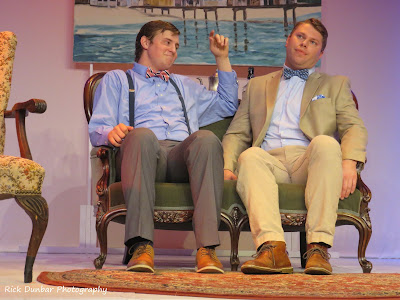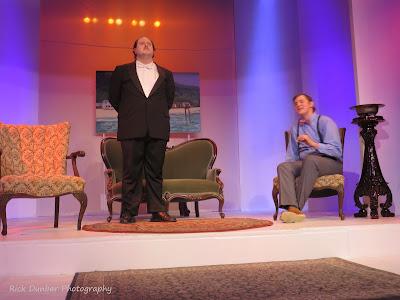 The Importance of Being Ernest is a play written by Oscar Wilde in 1895. A trivial comedy written for serious people, its zany story line is a handbag packed with social escapists, secret personas, closet engagements, and lover’s entanglements with a mythical suitor. The whole whacky affair is now unfolding at the James F. Dean Theatre in Summerville with a bit of a twist--it all unravels right here in the Lowcountry--Charleston and Summerville to be specific.
The Importance of Being Ernest is a play written by Oscar Wilde in 1895. A trivial comedy written for serious people, its zany story line is a handbag packed with social escapists, secret personas, closet engagements, and lover’s entanglements with a mythical suitor. The whole whacky affair is now unfolding at the James F. Dean Theatre in Summerville with a bit of a twist--it all unravels right here in the Lowcountry--Charleston and Summerville to be specific.The play opens in Charleston with Algernon Moncrieff (Erik Brower) receiving his best friend (Jacob Sunding) whom he knows as Ernest with last name Worthing. Ernest has come from Summerville to propose to Algernon's cousin, Gwendolen Fairfax (Minna Schubert), daughter of the formidable Lady Bracknell (Susie Hallatt). Algernon, however, refuses his consent to the engagement until Ernest explains why his cigarette case bears the inscription referring to him as Uncle Jack.
Ernest is forced to admit to living a double life. In Summerville, he portrays a respectable lifestyle for the benefit of his young ward, Cecily Cardew (Megan Fife-Malasky), and goes by the name of John also nicknamed Jack, at the same time pretending to be concerned about a brother living in Charleston named Ernest who indulges in wicked ways. On his visits to Charleston, John assumes the identity of the made-up philandering Ernest. Algernon confesses a similar deception. He pretends to have an invalid friend named Bunbury in the country, whom he can visit whenever he wishes to avoid unwelcome social obligations.
 John refuses to tell Algernon the location of his country estate, but after proposing to Gwendolen as Ernest and unsuccessfully acquiring consent from Lady Bracknell after revealing he was adopted by an old man who discovered him as a baby in a handbag at a train station, Algernon overhears him giving his country address to Gwendolen. Next, Algernon makes a surprise visit to John's Summerville estate pretending to be his brother, Ernest Worthing and meets Cecily. Long fascinated by Uncle Jack's until now never before seen black sheep brother, she can't help but to fall in love with Algernon, who is pretending to be Ernest. Pretty wild stuff so far, but the best is yet to come.
John refuses to tell Algernon the location of his country estate, but after proposing to Gwendolen as Ernest and unsuccessfully acquiring consent from Lady Bracknell after revealing he was adopted by an old man who discovered him as a baby in a handbag at a train station, Algernon overhears him giving his country address to Gwendolen. Next, Algernon makes a surprise visit to John's Summerville estate pretending to be his brother, Ernest Worthing and meets Cecily. Long fascinated by Uncle Jack's until now never before seen black sheep brother, she can't help but to fall in love with Algernon, who is pretending to be Ernest. Pretty wild stuff so far, but the best is yet to come.Gwendolen soon arrives to see her fiancé, so named Ernest, meets Cecily, and bordering on a potential catfight, the genteel blue gloves come off as the two of them spar over their one and only Ernest. Exquisitely portrayed by Megan and Minna, the encounter generates one of the more exceptional and endearing acting moments of the play.
As usual, Chrissy Eliason and Company crafted a brilliant, and I emphasize brilliant, set for Earnest. The predominantly white theme of the proscenium evoked a sense of purity and respectability, but as with Earnest, the obvious is the ambiguous. From the perspective of the audience, the props and costumes stood out like a hologram against the stage's white backdrop and subtle pastel lighting.
Director Joseph Demerly did an excellent job at casting the character of the actor with the character of the script. Without a doubt, if I were to look at a photograph of the cast in full dress, I would have been able to match the body to the name. Likewise, the chosen actors did an excellent job bringing their character to life.
 Susie Hallatt as Lady Bracknell is snobbish, domineering, and as presumptuous as her brown patterned dress, Minna Schubert as Gwendolen graced the stage with an air of southern sophistication and pretentiousness, and Megan Fife-Malasky as Cecily was naive and unspoiled as a pink rose. Jacob Sunding as John a.k.a. Ernest was spot on with his character's gentleman-like southern swag with an accent to match and Erik Brower was as witty and confrontational as his character Algernon, who is given to making pronouncements that either make no sense at all or touch on something profound.
Susie Hallatt as Lady Bracknell is snobbish, domineering, and as presumptuous as her brown patterned dress, Minna Schubert as Gwendolen graced the stage with an air of southern sophistication and pretentiousness, and Megan Fife-Malasky as Cecily was naive and unspoiled as a pink rose. Jacob Sunding as John a.k.a. Ernest was spot on with his character's gentleman-like southern swag with an accent to match and Erik Brower was as witty and confrontational as his character Algernon, who is given to making pronouncements that either make no sense at all or touch on something profound.Robert Venne (Butler Merriman) and Jason Pallay (Butler Lane) serve up some goodies and Deb Abbey as the rigid Miss Prism carries some of her own baggage and has romantic feelings for Reverend Canon Chausable played by David Hallatt.
The Importance of Being Earnest is Oscar Wilde’s social version of Bud Abbott's and Lou Costello's "Who's on first, what's on second, and I don't know is on third." You need to pay close attention to the dialogue throughout or you may miss a key piece of revelation that will later leave you scratching your head and trying to catch up. It is profoundly interesting, entertainingly trivial, and seriously humorous.
Now showing September 23rd to October 2nd.
Purchase your ticket for The Importance of Being Earnest.






















